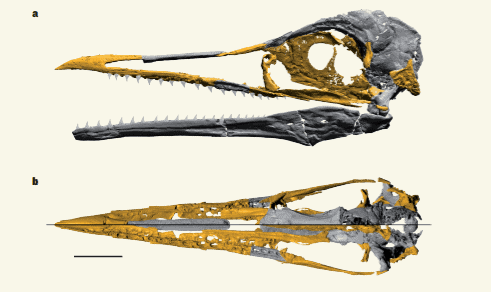New fossils show that the transition from dinosaur to bird beaks was much more complex than we previously believed.

CT-scan-based skull restoration and life reconstruction of the toothed stem bird Ichthyornis dispar, showing that the first form of the avian beak was a precision pincer-tip probably used for fine manipulation. Image Credits: Michael Hanson and Bhart-Anjan S. Bhullar.
The main perk of being a geologist is that you get to make silly jokes. For instance, every time someone makes a comment about dinosaurs being extinct, you can just chime in and say that dinosaurs aren’t gone — they’re all around us. After a few moments of confusion, you can explain that birds are actually dinosaurs, and slowly retreat after seeing the annoyed gazes directed at you. In all seriousness though, the current scientific consensus is that birds are a group of theropod dinosaurs that originated during the Mesozoic Era, and through successive adaptations, developed into the incredibly diverse group we see today.
There are, of course, dramatic differences between birds and dinosaurs. Aside from the obvious flying wings, there’s also the beak. The skulls of modern birds are dramatically different from those of dinosaurs, featuring several adaptations: an enlarged and toothless beak, bigger braincases, weaker jaw-closing muscles and more articulated skulls with mobile palates and suspended jaws.
However, researchers don’t really know which of these features came first and which followed — this is where the new fossils come in.
“The distinctive features of birds, from beaks to feathers, provide a stark separation between avians and other animal groups. But how did the features of the bird skull evolve? On page 96, Field et al. present a computerized reconstruction of the skull of a pivotal early bird that brings avian evolution into sharper focus,” writes Kevin Padian, Professor of Integrative Biology at the University of California, Berkeley, in an accompanying News & Views article.
Bhart-Anjan Bhullar and colleagues describe four new fossils of the early bird Ichthyornis dispar. Ichtyornis had a 60-centimeter wingspan and a toothy, tern-like beak. It lived some 100–66 million years ago, and it fills a somewhat unique spot in the fossil record: it’s new enough to resemble modern birds, but it also maintains many of its archaic features.
Paleontologists have known about this species for more than a century. It was first discovered in 1870, but the first fossils were incomplete and damaged — and no new fossils had been found until now. The newly discovered fossils are complete and 3D (as opposed to flattened), offering a much better look into what the species look like. The research team carried out complete CT scans, reconstructing the bird’s skull.
They found that, like dinosaurs, Ichthyornis sports holes in its skull for large jaw-closing muscles. However, unlike them, the bird also has a largely modern, articulated skull, which features a small, primitive beak on its jaw tips. This unusual mix of features would have enabled preening and object manipulation after arms became wings, and goes to show that the feeding apparatus of living birds evolved earlier than previously thought.
The brain was also relatively modern, but the temporal region was unexpectedly dinosaurian. This combination of features documents that important attributes of the avian brain and palate evolved before the reduction of jaw musculature and the full transformation of the beak, researchers write in the study.
“Moreover, ‘bird brain’ is not the insult you might think. Bird brains are larger relative to their body size than is the case for reptiles, and the relative size of bird brains is comparable to that of placental mammals. As birds evolved from their dinosaur ancestors, the bones that protect the brain enlarged to keep pace with the changes in brain size,” Padian continues.
But, aside from providing some answers, this study raises even more questions. For instance, how did the biological transition from dinosaur to bird change the animal’s diet, and what ecological habits are associated with the loss of teeth from the upper jaw and the evolution of the horny beak that covers it? While we still don’t know all those things, this beautiful reconstruction provides a valuable stepping stone for future studies, and will undoubtedly serve as a resource for future paleontological studies.
The study “Complete Ichthyornis skull illuminates mosaic assembly of the avian head” has been published in Nature.










